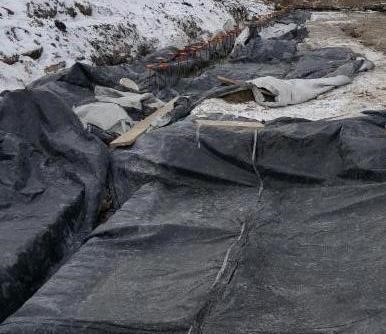Leading Thoughts: 11/25/18 Freezing Weather and Geopier® Ground Improvement

Geopier Rammed Aggregate Pier® construction in freezing weather conditions is a challenge that can be addressed at Ground Improvement Engineering.
Deanna Chambers, P.E., our Geopier design engineer in Nebraska, addresses protecting the subgrade from freezing as temperatures dip.
 Geopier elements at bottom-of-footing
Geopier elements at bottom-of-footing
As the construction season enters into the colder autumn months, foundation preparation and Geopier® ground improvement take on greater urgency. One reason is the potential for subgrade freezing.
As evening temperatures dip below freezing, and cold rains and early snows enter the equation, your unprotected subgrade will begin to freeze. Left unaddressed, this could delay foundation preparation and ground improvement until the spring thaw.
We like to put things in simple, concise terms: “The subgrade should not be allowed to freeze before or after the Geopier construction!” That’s a good rule of thumb but let’s go deeper.
We improve the soils around a Geopier element by forcing the crushed aggregate into the pier sidewalls to provide lateral resistance and reduce compressibility. If the soils are frozen, then the Geopier construction does not improve matters at all. If the soils freeze after our work, then the relaxation from the spring thaw compromises both the Rammed Aggregate Pier® and surrounding soil stiffness.
Another construction-related consideration is drilling through frozen soil. This slows down the process, and is tough on the drilling equipment and tooling.
If your schedule does need winter Geopier installation, here are two proactive methods and one reactive method to get the work done.
1. Lower footings below frost level.
If you are planning Geopier foundation support only, interior footings can be lowered to design frost depth similar to the exterior footings. This allows the contractor to construct footings throughout the winter.
2. Place protective cover.
If you have floor slab support or shallow interior footings, there are methods of “covering” the subgrade to prevent or greatly restrict frost penetration. This could include specialty frost blankets, additional fill placed above the improved subgrade, or placing straw or even snow piles.
 Frost Blankets
Frost Blankets
3. Defrost the subgrade.
A reactive method is to let the subgrade freeze, then bring in a frost removal heating system before the Geopier or foundation work. This is usually expensive and not practical for large areas.
Employing one of these methods can keep the ball rolling on Geopier ground improvement. It is definitely something to discuss with your project team and Geopier designer. Please reach out to your local GIE engineer: https://www.groundimprovementeng.com/aboutus/
